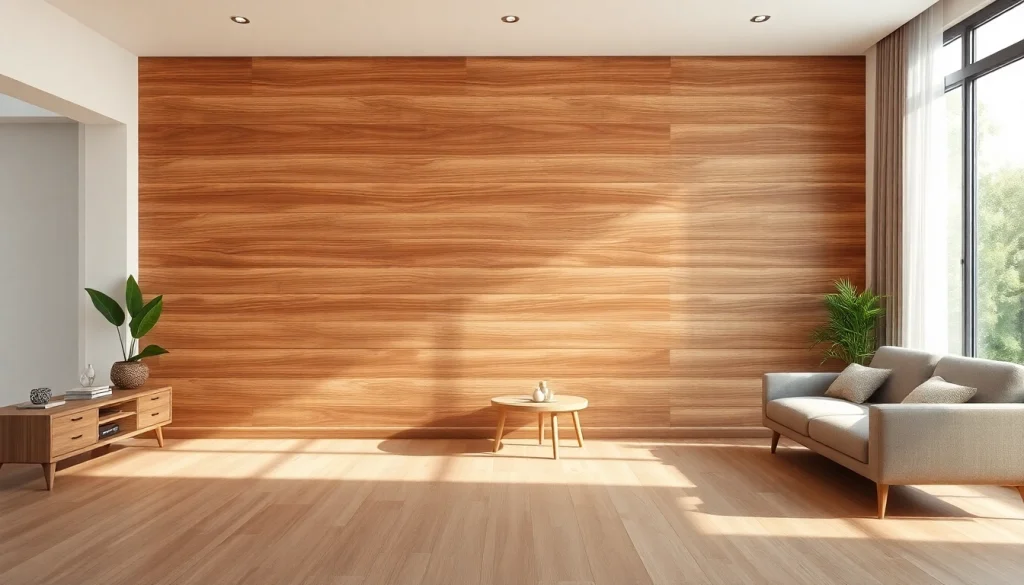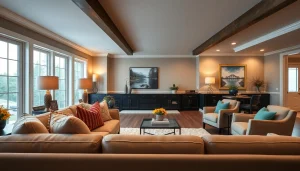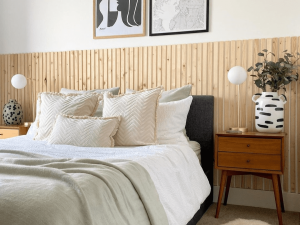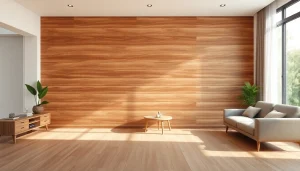Elevate Your Space with Stunning Wood Wall Covering Ideas

Understanding Wood Wall Covering
What is Wood Wall Covering?
Wood wall covering is a versatile interior design element that makes use of wood materials to enhance the aesthetic appeal of walls in residential and commercial spaces. It can come in various forms, including panels, planks, or even as sheathing, allowing for modifications in style, texture, and finish. This material not only serves a decorative purpose but also adds an element of warmth and sophistication to a room. The use of wood wall covering can provide acoustic benefits, improving sound quality within a space while contributing to overall comfort.
Benefits of Using Wood Wall Covering
There are numerous advantages to using wood wall covering. It offers aesthetic benefits, allowing for various styles ranging from rustic to modern. Moreover, wood has natural insulating properties, which help in regulating indoor temperatures and enhancing energy efficiency. Wood also boasts durability, making it a long-lasting choice for wall coverings. Furthermore, wood wall covering can enhance indoor acoustics, reducing echo and sound penetration, which is especially beneficial in large spaces or areas requiring privacy. Finally, wood can be sustainable when sourced responsibly, contributing to environmentally friendly design practices.
Types of Wood Wall Covering Materials
When choosing wood wall coverings, various materials are available, each bringing unique qualities and benefits:
- Plywood: This engineered wood is lightweight, versatile, and comes in various finishes, making it suitable for different design needs.
- Solid Wood Panels: Made from one piece of timber, these panels showcase natural grain and texture, providing a premium feel.
- Reclaimed Wood: Utilizing repurposed wood not only reduces waste but also adds a story and character to any space.
- Composite Wood Products: These are made from a blend of wood fibers and resins, providing durability and affordability.
Design Inspiration for Wood Wall Covering
Contemporary Styles for Wood Wall Covering
In contemporary interior design, wood wall covering can add refinement with a modern twist. Sleek, minimalist designs often utilize light-colored woods with clean lines and minimal embellishment, creating open and airy spaces. Also, horizontal plank installations can provide a sense of width and warmth. For instance, pairing a light oak wood covering with white walls can make a statement without being overwhelming.
Rustic and Vintage Looks with Wood Wall Covering
Rustic designs can be enhanced using darker woods, such as walnut or reclaimed barn wood, which provide a vintage feel. These woods often feature knots and imperfections that tell a story, thus adding charm and character to interiors. The incorporation of wood beams alongside wood wall coverings can further accentuate the rustic feel of the space, making it feel both inviting and homely.
Eclectic Combinations Using Wood Wall Covering
Eclectic design allows for vibrant creativity and innovation. Mixing different types of wood wall coverings can create fascinating patterns and textures. For example, using herringbone patterns with contrasting tones or combining matte finishes with high-gloss accents can result in stunning visual effects. Artwork or shelving made from contrasting materials, such as metal or glass, can provide additional depth to design.
Installation Tips for Wood Wall Covering
Preparing Your Space for Wood Wall Covering
Before the installation process begins, it’s vital to prepare the space adequately. Start by clearing the walls of any previous coverings, cleaning the surface, and ensuring it’s dry and even. It’s beneficial to assess the room’s humidity levels, as wood is sensitive to moisture. Make sure to acclimate the wood to the room environment for at least 48 hours prior to installation, allowing the wood to adjust to temperature and moisture conditions.
Step-by-Step Installation Guide for Wood Wall Covering
Installing wood wall covering can be achieved through a series of detailed steps:
- Measure the Space: Calculate the area to be covered to determine how much material you need.
- Cut the Panels: Using appropriate tools, cut the wood panels to fit the measurements you’ve gathered.
- Mark Guidelines: On the wall, pencil out straight lines to guide the placement of your panels.
- Apply Adhesive: Depending on your material, use strong adhesive or nails to secure the panels against the wall.
- Check for Level: As you add each panel, ensure they are aligned properly to avoid uneven surfaces.
- Add Finishing Touches: Seal edges with caulk or trim to achieve a polished and seamless look.
Common Mistakes to Avoid with Wood Wall Covering
Several common pitfalls can affect the quality of your installation:
- Ignoring Acclimation: Failing to acclimate the wood can lead to warping or gaps.
- Improper Measurements: Always double-check measurements before cutting materials to prevent wastage.
- Neglecting Surface Prep: Surfaces must be clean and dry for effective adhesive application.
- Forgetting Ventilation: Ensure adequate airflow for the adhesive to cure properly during installation.
Maintenance of Wood Wall Covering
Cleaning and Caring for Wood Wall Covering
To maintain the beauty and longevity of wood wall covering, regular cleaning is essential. Dust and dirt can accumulate over time, so use a soft, dry cloth to wipe down surfaces regularly. For deeper cleaning, a damp cloth with a gentle wood cleaner can be used, followed immediately by drying the area to prevent moisture absorption. Avoid using harsh chemicals that may damage the finish of the wood.
Preventing Damage to Wood Wall Covering
Preventative measures play a crucial role in safeguarding wood wall coverings. Implement coasters and mats under decorative items to prevent scratches and dents. Additionally, consider maintaining stable humidity levels in the room, as fluctuations can lead to warping or cracking. Using furniture polish occasionally can help maintain the protective finish of wood while adding luster.
Restoration Techniques for Wood Wall Covering
Over time, wear and tear may necessitate restoration. For minor scratches, a simple touch-up of stains or sealants can restore the appearance. For more significant blemishes, sanding down the affected area and applying a new coat of finish can revive the wood’s sheen. In severe cases, parts of wall covering may need to be replaced, at which point sourcing matching materials will ensure a consistent look.
Incorporating Wood Wall Covering in Different Spaces
Wood Wall Covering in Living Areas
In living areas, wood wall covering serves as a focal point, drawing attention while providing warmth and texture. Feature walls behind entertainment centers or fireplaces often employ bold wood shades for dramatic effect. Light wood tones can make smaller spaces feel larger and more open, whereas darker tones contribute to a cozy atmosphere.
Using Wood Wall Covering in Commercial Spaces
In commercial settings, wood wall covering can enhance brand identity and create inviting environments for customers. A cafe, for instance, could use reclaimed wood for a rustic-themed ambiance, effectively attracting customers seeking a unique experience. Offices can benefit from strategic wood paneling, promoting both professionalism and comfort in the workplace.
Creative Applications of Wood Wall Covering
Beyond typical wall installations, wood can be creatively used in various ways. Wood wall covering can be integrated into cabinetry, creating harmonious transitions between walls and built-in furniture. Additionally, applications such as headboards, feature ceilings, or even as a backdrop for artwork unleash the full potential of wood in interior design, providing both utility and visual appeal.







